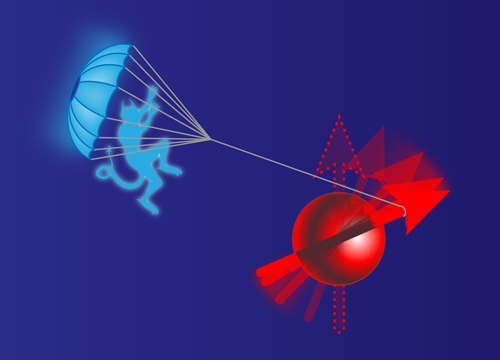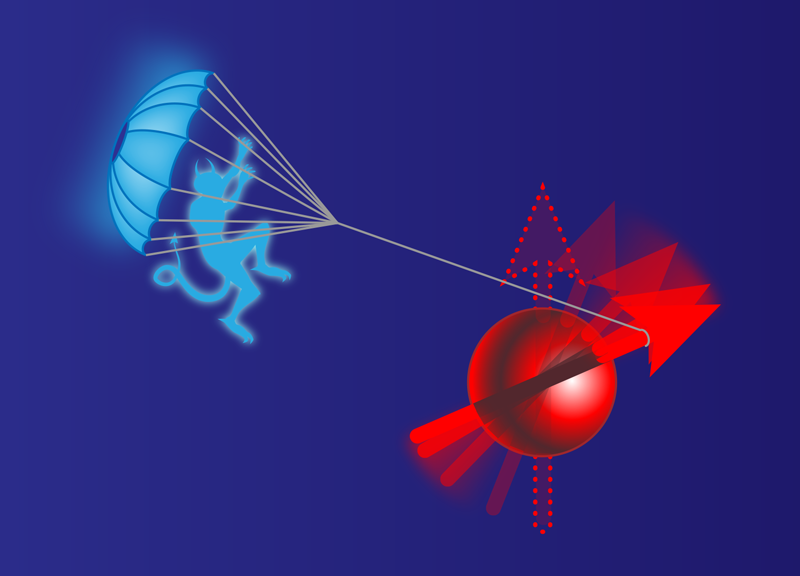Maxwell’s Demon Meets Nonequilibrium Quantum Thermodynamics
In 1867, James Clerk Maxwell imagined a “neat fingered” being with the ability to sort particles in a gas based on their speed [1]. Maxwell’s demon, as the being became known, could quickly open and shut a trap door in a box containing a gas and let hot particles through to one side of the box but restrict cold ones to the other. At first glance, this scenario seems to contradict the second law of thermodynamics, as the overall entropy appears to decrease. Almost 150 years on, Maxwell’s paradox, which was only properly understood a century after its original inception, continues to inspire physicists. In particular, there is currently a large activity in trying to understand the thermodynamics of devices that operate in the quantum domain and are out of thermal equilibrium, and how a unit like Maxwell’s demon may be used to control them and enhance their performance. Roberto Serra from the Federal University of ABC, Brazil, and colleagues [2] have now implemented a Maxwell’s demon that can control and rectify entropy production in a quantum system driven out of thermal equilibrium (Fig. 1). This finding paves the way to achieving the ultimate goal of complete control of nonequilibrium quantum systems at the nanoscale and beyond.
Maxwell’s demon was named by Lord Kelvin in a hugely influential paper on the dissipation of energy [3]. With the original Greek meaning of the word in mind, Kelvin chose the name not to imply any foul play but rather to emphasize the role of the being’s intelligence. In 1929, stimulated by this abstract notion of intelligence, Leo Szilard wrote a paper on the decrease of entropy by intelligent beings [4]. In this classic work, Szilard considered a Maxwell’s demon that controlled the thermodynamic cycle of a one-particle heat engine. By making measurements on the system and using the acquired information, the demon could extract work from the closed cycle—once again in apparent contradiction with the second law of thermodynamics. In fact, by considering this simple cycle, Szilard was achingly close to resolving the paradox. In short, he believed that there was an entropic penalty caused by the measurements that balanced the work extracted by the demon.
This belief was shown much later to be false when Rolf Landauer [5] finally exorcised the demon by demonstrating that the entropic penalty was paid not in the measurements themselves but in the erasure of the acquired information that follows the measurements. Nevertheless, Szilard’s work was visionary, as it not only emphasized the role of information in physics, but it also prophesied a field broadly known as cybernetics, which can be understood as the study of the control of machines by means of information processing. Maxwell’s demon can be seen as a feedback controller that operates on a system in order to force it to perform useful tasks.
In the more than six decades since Landauer resolved Maxwell’s paradox, researchers have implemented demon-like devices in classical and quantum systems in thermal equilibrium, the conditions that Szilard envisaged. Serra and colleagues now demonstrate a Maxwell’s demon in a quantum system out of thermal equilibrium. In contrast to standard thermodynamics, nonequilibrium thermodynamics involves transformations that drive the system away from equilibrium. In the nonequilibrium domain, fluctuations of thermodynamic quantities become relevant and additional entropy is produced. This entropy production can manifest as additional heat dissipation into the surroundings and hence serves to decrease the thermodynamic efficiency of, for example, a thermal machine. As devices are pushed towards the nanoscale and beyond, they become more susceptible to thermal and quantum fluctuations. Therefore, it has become increasingly important to understand this entropy production and to control it.
Serra and co-workers considered a two-level quantum system based on the nuclear spin of a carbon atom. Preparing this spin system in an equilibrium state and then driving it out of equilibrium using magnetic fields, the researchers focused on controlling the associated entropy production. They did so by implementing a Maxwell’s demon in the form of a feedback control mechanism. In a nutshell, the mechanism works as follows: it acquires and stores information about the state of the carbon atom using an auxiliary hydrogen nucleus; it then applies magnetic fields to the carbon nucleus that are conditioned on the state of the hydrogen nucleus. The authors demonstrate that, by performing such conditioned manipulations, the entropy production can be controlled and even reduced. They also show that the amount of entropy production is in excellent agreement with models of nonequilibrium thermodynamics that account for both thermal and quantum fluctuations [6] and the feedback control mechanism [7].
The acquisition of thermodynamic quantities in a nonequilibrium setting, such as the entropy produced in the authors’ experiment, is notoriously difficult in its own right (as demonstrated in a previous study [8]). Serra and colleagues’ inclusion of a feedback control unit into such a setting represents an important development in the growing interdisciplinary field of quantum thermodynamics [9]. The techniques employed by the authors in this work could be used to help control and enhance the performance of the thermal machines of the future. And when combined with current progress in machine learning, studies such as this promise to inspire a new era of what one might call quantum cybernetics.
This research is published in Physical Review Letters.
References
- J. C. Maxwell, “Letter to Peter Guthrie Tait, 13 November 1867,” The Scientific Letters and Papers of James Clerk Maxwell (Cambridge University Press, Cambridge, 1995).
- P. A. Camati, J. P. S. Peterson, T. B. Batalhão, K. Micadei, A. M. Souza, R. S. Sarthour, I. S. Oliveira, and R. M. Serra, “Experimental Rectification of Entropy Production by Maxwell’s Demon in a Quantum System,” Phys. Rev. Lett. 117, 240502 (2016).
- W. Thomson, “Kinetic Theory of the Dissipation of Energy,” Nature 9, 441 (1874).
- L. Szilard, “On the Decrease of Entropy in a Thermodynamic System by the Intervention of Intelligent Beings,” Z. Phys. 53, 840 (1929).
- R. Landauer, “Irreversibility and Heat Generation in the Computing Process,” IBM J. Res. Dev. 5, 183 (1961).
- M. Campisi, P. Hänggi, and P. Talkner, “Colloquium: Quantum fluctuation relations: Foundations and applications,” Rev. Mod. Phys. 83, 771 (2011).
- Y. Morikuni and H. Tasaki, “Quantum Jarzynski-Sagawa-Ueda Relations,” J. Stat. Phys. 143, 1 (2011).
- T. B. Batalhão, A. M. Souza, L. Mazzola, R. Auccaise, R. S. Sarthour, I. S. Oliveira, J. Goold, G. De Chiara, M. Paternostro, and R. M. Serra, “Experimental Reconstruction of Work Distribution and Study of Fluctuation Relations in a Closed Quantum System,” Phys. Rev. Lett. 113, 140601 (2014).
- J. Goold, M. Huber, A. Riera, L. del Rio, and P. Skrzypczyk, “The Role of Quantum Information in Thermodynamics—A Topical Review,” J. Phys. A 49, 143001 (2016).





